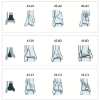Intra-articular fractures of the distal tibia: Current concepts of management
- PMID: 28932487
- PMCID: PMC5590002
- DOI: 10.1302/2058-5241.2.150047
Intra-articular fractures of the distal tibia: Current concepts of management
Abstract
Results of the treatment of intra-articular fractures of the distal tibia have improved significantly during the last two decades.Recognition of the role of soft tissues has led to the development of a staged treatment strategy. At the first stage, joint-bridging external fixation and fibular fixation are performed. This leads to partial reduction of the distal tibial fracture and allows time for the healing of soft tissues and detailed surgical planning.Definitive open reduction and internal fixation of the tibial fracture is performed at a second stage, when the condition of the soft tissues is safe. The preferred surgical approach(es) is chosen based on the fracture morphology as determined from standard radiographic views and computed tomography.Meticulous atraumatic soft-tissue handling and the use of modern fixation techniques for the metaphyseal component such as minimally invasive plate osteosynthesis further facilitate healing. Cite this article: EFORT Open Rev 2017;2:352-361. DOI: 10.1302/2058-5241.2.150047.
Keywords: closed treatment; complications; diagnosis; distal tibia; intra-articular fractures; outcomes; surgical treatment.
Conflict of interest statement
ICMJE Conflict of interest statement: None declared.
Figures








Similar articles
-
Open Reduction and Internal Fixation of Distal Tibial Pilon Fractures.JBJS Essent Surg Tech. 2019 Sep 11;9(3):e29. doi: 10.2106/JBJS.ST.18.00093. eCollection 2019 Jul-Sep. JBJS Essent Surg Tech. 2019. PMID: 32021729 Free PMC article.
-
Treatment strategy for tibial plateau fractures: an update.EFORT Open Rev. 2017 Mar 13;1(5):225-232. doi: 10.1302/2058-5241.1.000031. eCollection 2016 May. EFORT Open Rev. 2017. PMID: 28461952 Free PMC article.
-
A staged protocol for soft tissue management in the treatment of complex pilon fractures.J Orthop Trauma. 2004 Sep;18(8 Suppl):S32-8. doi: 10.1097/00005131-200409001-00005. J Orthop Trauma. 2004. PMID: 15472563
-
Minimally invasive percutaneous plate osteosynthesis of fractures of the distal tibia.Instr Course Lect. 2004;53:471-5. Instr Course Lect. 2004. PMID: 15116635 Review.
-
High-energy pilon fractures management: State of the art.EFORT Open Rev. 2017 Mar 13;1(10):354-361. doi: 10.1302/2058-5241.1.000016. eCollection 2016 Oct. EFORT Open Rev. 2017. PMID: 28461913 Free PMC article. Review.
Cited by
-
Treatment of Soft Tissue Defects after Minimally Invasive Plate Osteosynthesis in Fractures of the Distal Tibia: Clinical Results after Reverse Sural Artery Flap.Medicina (Kaunas). 2023 Sep 30;59(10):1751. doi: 10.3390/medicina59101751. Medicina (Kaunas). 2023. PMID: 37893469 Free PMC article.
-
A systematic review and meta-analysis of functional outcomes and complications following external fixation or open reduction internal fixation for distal intra-articular tibial fractures: an update.Eur J Orthop Surg Traumatol. 2019 May;29(4):907-917. doi: 10.1007/s00590-019-02368-9. Epub 2019 Feb 9. Eur J Orthop Surg Traumatol. 2019. PMID: 30739163
-
Treatment of Posttraumatic Osteoarthritis Secondary to a Chronic Plafond Fracture: A Case Report.J Chiropr Med. 2019 Sep;18(3):219-224. doi: 10.1016/j.jcm.2019.02.005. Epub 2020 Aug 21. J Chiropr Med. 2019. PMID: 32874162 Free PMC article.
-
Retrograde tibial intramedullary nail versus minimally invasive locking plate for extra-articular distal tibial fractures: a comparative and retrospective study.J Orthop Surg Res. 2024 Aug 17;19(1):481. doi: 10.1186/s13018-024-04979-3. J Orthop Surg Res. 2024. PMID: 39152451 Free PMC article.
-
Advances in Understanding and Managing Floating Knee Injuries: A Comprehensive Review.Cureus. 2024 Mar 28;16(3):e57122. doi: 10.7759/cureus.57122. eCollection 2024 Mar. Cureus. 2024. PMID: 38681444 Free PMC article. Review.
References
-
- Anglen JO. Early outcome of hybrid external fixation for fracture of the distal tibia. J Orthop Trauma 1999;13:92-97. - PubMed
-
- Collinge C, Kuper M, Larson K, Protzman R. Minimally invasive plating of high-energy metaphyseal distal tibia fractures. J Orthop Trauma 2007;21:355-361. - PubMed
-
- Krettek C, Bachmann S. Pilon- fractures. Part 1: Diagnostics, treatment strategies and approaches. Chirurg 2015;86:87-101. - PubMed
-
- Lomax A, Singh A, N Jane M, C Senthil K. Complications and early results after operative fixation of 68 pilon fractures of the distal tibia. Scott Med J 2015;60:79-84. - PubMed
Publication types
LinkOut - more resources
Full Text Sources
Other Literature Sources

